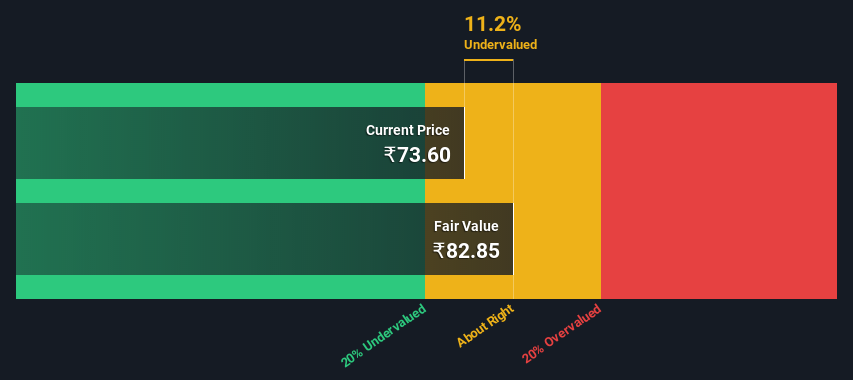Calculating The Intrinsic Value Of Emmbi Industries Limited (NSE:EMMBI)

Key Insights
- Using the 2 Stage Free Cash Flow to Equity, Emmbi Industries fair value estimate is ₹82.85
- Emmbi Industries' ₹73.60 share price indicates it is trading at similar levels as its fair value estimate
- Emmbi Industries' peers are currently trading at a premium of 336% on average
In this article we are going to estimate the intrinsic value of Emmbi Industries Limited (NSE:EMMBI) by taking the expected future cash flows and discounting them to today's value. We will use the Discounted Cash Flow (DCF) model on this occasion. There's really not all that much to it, even though it might appear quite complex.
We would caution that there are many ways of valuing a company and, like the DCF, each technique has advantages and disadvantages in certain scenarios. Anyone interested in learning a bit more about intrinsic value should have a read of the Simply Wall St analysis model.
View our latest analysis for Emmbi Industries
Step By Step Through The Calculation
We use what is known as a 2-stage model, which simply means we have two different periods of growth rates for the company's cash flows. Generally the first stage is higher growth, and the second stage is a lower growth phase. To begin with, we have to get estimates of the next ten years of cash flows. Seeing as no analyst estimates of free cash flow are available to us, we have extrapolate the previous free cash flow (FCF) from the company's last reported value. We assume companies with shrinking free cash flow will slow their rate of shrinkage, and that companies with growing free cash flow will see their growth rate slow, over this period. We do this to reflect that growth tends to slow more in the early years than it does in later years.
Generally we assume that a dollar today is more valuable than a dollar in the future, so we discount the value of these future cash flows to their estimated value in today's dollars:
10-year free cash flow (FCF) forecast
| 2023 | 2024 | 2025 | 2026 | 2027 | 2028 | 2029 | 2030 | 2031 | 2032 | |
| Levered FCF (₹, Millions) | ₹144.2m | ₹158.3m | ₹172.3m | ₹186.5m | ₹201.0m | ₹216.1m | ₹231.9m | ₹248.5m | ₹266.0m | ₹284.6m |
| Growth Rate Estimate Source | Est @ 10.98% | Est @ 9.73% | Est @ 8.85% | Est @ 8.24% | Est @ 7.81% | Est @ 7.51% | Est @ 7.30% | Est @ 7.15% | Est @ 7.05% | Est @ 6.98% |
| Present Value (₹, Millions) Discounted @ 17% | ₹123 | ₹115 | ₹107 | ₹98.8 | ₹90.9 | ₹83.4 | ₹76.3 | ₹69.8 | ₹63.7 | ₹58.2 |
("Est" = FCF growth rate estimated by Simply Wall St)
Present Value of 10-year Cash Flow (PVCF) = ₹886m
The second stage is also known as Terminal Value, this is the business's cash flow after the first stage. For a number of reasons a very conservative growth rate is used that cannot exceed that of a country's GDP growth. In this case we have used the 5-year average of the 10-year government bond yield (6.8%) to estimate future growth. In the same way as with the 10-year 'growth' period, we discount future cash flows to today's value, using a cost of equity of 17%.
Terminal Value (TV)= FCF2032 × (1 + g) ÷ (r – g) = ₹285m× (1 + 6.8%) ÷ (17%– 6.8%) = ₹2.9b
Present Value of Terminal Value (PVTV)= TV / (1 + r)10= ₹2.9b÷ ( 1 + 17%)10= ₹598m
The total value, or equity value, is then the sum of the present value of the future cash flows, which in this case is ₹1.5b. To get the intrinsic value per share, we divide this by the total number of shares outstanding. Relative to the current share price of ₹73.6, the company appears about fair value at a 11% discount to where the stock price trades currently. Valuations are imprecise instruments though, rather like a telescope - move a few degrees and end up in a different galaxy. Do keep this in mind.

Important Assumptions
Now the most important inputs to a discounted cash flow are the discount rate, and of course, the actual cash flows. Part of investing is coming up with your own evaluation of a company's future performance, so try the calculation yourself and check your own assumptions. The DCF also does not consider the possible cyclicality of an industry, or a company's future capital requirements, so it does not give a full picture of a company's potential performance. Given that we are looking at Emmbi Industries as potential shareholders, the cost of equity is used as the discount rate, rather than the cost of capital (or weighted average cost of capital, WACC) which accounts for debt. In this calculation we've used 17%, which is based on a levered beta of 1.068. Beta is a measure of a stock's volatility, compared to the market as a whole. We get our beta from the industry average beta of globally comparable companies, with an imposed limit between 0.8 and 2.0, which is a reasonable range for a stable business.
SWOT Analysis for Emmbi Industries
- Debt is well covered by cash flow.
- Dividends are covered by earnings and cash flows.
- Earnings declined over the past year.
- Interest payments on debt are not well covered.
- Dividend is low compared to the top 25% of dividend payers in the Packaging market.
- Current share price is below our estimate of fair value.
- Lack of analyst coverage makes it difficult to determine EMMBI's earnings prospects.
- No apparent threats visible for EMMBI.
Looking Ahead:
Although the valuation of a company is important, it is only one of many factors that you need to assess for a company. DCF models are not the be-all and end-all of investment valuation. Rather it should be seen as a guide to "what assumptions need to be true for this stock to be under/overvalued?" For example, changes in the company's cost of equity or the risk free rate can significantly impact the valuation. For Emmbi Industries, there are three essential factors you should assess:
- Risks: You should be aware of the 4 warning signs for Emmbi Industries (2 make us uncomfortable!) we've uncovered before considering an investment in the company.
- Management:Have insiders been ramping up their shares to take advantage of the market's sentiment for EMMBI's future outlook? Check out our management and board analysis with insights on CEO compensation and governance factors.
- Other High Quality Alternatives: Do you like a good all-rounder? Explore our interactive list of high quality stocks to get an idea of what else is out there you may be missing!
PS. Simply Wall St updates its DCF calculation for every Indian stock every day, so if you want to find the intrinsic value of any other stock just search here.
Valuation is complex, but we're here to simplify it.
Discover if Emmbi Industries might be undervalued or overvalued with our detailed analysis, featuring fair value estimates, potential risks, dividends, insider trades, and its financial condition.
Access Free AnalysisHave feedback on this article? Concerned about the content? Get in touch with us directly. Alternatively, email editorial-team (at) simplywallst.com.
This article by Simply Wall St is general in nature. We provide commentary based on historical data and analyst forecasts only using an unbiased methodology and our articles are not intended to be financial advice. It does not constitute a recommendation to buy or sell any stock, and does not take account of your objectives, or your financial situation. We aim to bring you long-term focused analysis driven by fundamental data. Note that our analysis may not factor in the latest price-sensitive company announcements or qualitative material. Simply Wall St has no position in any stocks mentioned.
About NSEI:EMMBI
Emmbi Industries
Engages in the manufacturing, trading, and selling of high-density polyethylene (HDPE) and polypropylene (PP) woven polymer based products in India and internationally.
Slight with mediocre balance sheet.
Market Insights
Community Narratives





